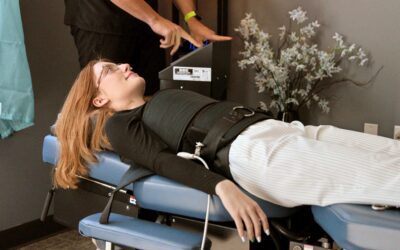Are you suffering from low back pain and can’t figure out why? Maybe your posture is poor, but you can’t seem to stand up straight, and your stomach sticks out.
You could have Lower Cross Syndrome, which is also known as Lower Crossed Syndrome, Lower Body Cross Syndrome or Crossed Pelvis Syndrome.
Lower Cross Syndrome occurs because your low back and hip flexors get too tight and shorten up. Your abdominal and gluteal muscles weaken, and your body compensates to remain upright. Over time this can cause your pelvis to become misaligned. This ‘crossing’ effect forms the basis of its nomenclature.
The human body is a complex, dynamic structure that depends on balance and symmetry to function at its best. But our sedentary lifestyles have led to several postural imbalances, among which Lower Cross Syndrome is a significant one.
Symptoms of Lower Cross Syndrome
The primary symptoms of Lower Cross Syndrome are a forward tilt of the pelvis and an increased curve in the lower back, which can give an impression of a protruding abdomen and buttocks. This posture, in turn, often leads to chronic lower back pain, a complaint that brings many Lower Cross Syndrome sufferers to seek relief.
Other symptoms of Lower Cross Syndrome can include discomfort in the hips, knees, and even the neck and shoulders. The severity and the range of these symptoms can vary greatly among individuals, often depending on the extent of muscular imbalance and the duration of the condition.
Having your posture out of alignment can cause issues in different ways. For some people, their buttocks lift up and stick out. If you think of your pelvis like a bowl, you would spill your soup because the “bowl” is tipping forward. Your low back makes you look like you are pitching forward.
For others, their upper back appears to have a bulge, though not as severe as a hunchback. Their pelvis soup bowl is level, but their stomach protrudes forward.
Causes of Lower Cross Syndrome
A sedentary lifestyle lends itself to many health challenges, and Lower Cross Syndrome is one of them. If you sit for hours on end, some muscles will tighten and some will lengthen. Your body adapts to this misalignment. This can cause back pain, which makes slouching more comfortable than sitting up straight. This will exacerbate this condition.
This imbalance causes the telltale ‘crossed’ posture. Other factors like repetitive motion, inadequate stretching, and even aging can contribute to the development of Lower Cross Syndrome.
You can still develop Lower Cross Syndrome if you live an active lifestyle. For example, bicycling will tighten hip flexors and overwork quadriceps. This means the glutes don’t have to work as hard and they get weak.
Although cycling will strengthen your core to a point, skipping your ab workout may put you at risk for Lower Cross Syndrome, since weak abdominal muscles play a role. Doing your core exercises will help you avoid Lower Cross Syndrome and also improve your efficiency in cycling and other cardio activities.
Treatments For Lower Cross Syndrome
Your chiropractor can help significantly mitigate the symptoms and rectify the imbalances related to Lower Cross Syndrome. Chiropractors are uniquely trained to assess and correct postural misalignments, making them an ideal partner in managing and combating Lower Cross Syndrome.
Your chiropractor will start by making a thorough evaluation of your posture, muscle strength, and flexibility. This will include assessing the curvature of your spine, the tilt of your pelvis, and other physical signs indicative of Lower Cross Syndrome. We may also enquire about your lifestyle, work habits, and physical activities to identify possible contributing factors.
Our massage therapist can help loosen the muscles, while your chiropractor can fix your alignment issues, and both will relieve pain.
Depending on the severity, we might recommend seeing your doctor to get a physical therapy referral. Physical Therapists can help you with specific exercises and stretches to gradually strengthen your underused muscles and balance the affected muscle groups.
You can also try some home remedies to relieve pain and get started on the road to recovery.
Heat will relax tightness, and cold packs will reduce inflammation in sore muscles. Try rolling a foam roller over tight muscles, like your quads. You can also place the roller on the ground and gently roll on it for more pain relief.
Stretches will help, too. One simple stretch to help the hip flexors begins by kneeling on the ground. Adjust your right leg so the right quad and knee face the ceiling, with your right foot flat on the ground.
Lean forward until you feel a stretch in the front of your thigh. Hold for 20 seconds, then release and switch sides.
We’re Here To Help
Once Lower Cross Syndrome is diagnosed, your chiropractor will design a comprehensive treatment plan tailored to your specific needs. This will likely include a combination of spinal adjustments, soft tissue work, and stretching exercises for the tight muscles, coupled with strengthening exercises for the weakened ones.
In many cases, your chiropractor will also provide guidance on proper ergonomics, suggesting changes in workstation setup or seating arrangements to support improved posture.
Our goal is not just to treat your current problems, but empower you with the knowledge and tools to manage this condition in the long term. By teaching you proper stretching and strengthening techniques, we can help you to keep muscular imbalances in check.
Lower Cross Syndrome, while common, need not be a life sentence. Through the professional support and intervention of your chiropractor, you can work towards overcoming the muscular imbalances causing this condition.
With persistence, you will not just manage the symptoms but also reclaim the proper posture that is the cornerstone of overall physical health.
Don’t wait for chronic discomfort to dictate your life. Take the initiative, consult with a chiropractor, and embark on your journey towards improved postural health today!
Call 417 Spine to schedule an appointment and start conquering your pain.


